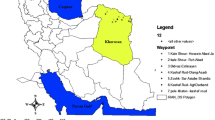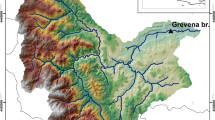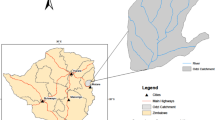Abstract
In order to effective management of water resources, an accurate estimate of the water transporting load is necessary. But no individual method has been shown to consistently provide accurate load estimates among different water sampling sites. We evaluated the accuracy of several load estimation methods by simulation of the relationship between river discharge and sediment yield, across a broad range of sampling and environmental conditions. Sediment rating curves (SRCs) are generally used to estimate the suspended sediment load of the rivers and drainage watersheds. Since the regression equations of the SRCs are obtained by logarithmic retransformation and have a little independent variable in this equation, they can be used to estimate the true sediment load of the rivers. One of the modification methods to compensate this bias is developing various correction factors. For optimization of SRCs and to evaluate the bias correction factors in Kale Shour and Kashaf Rud watersheds, seven hydrometric stations of this region were selected with the easy-to-find variables in the upstream watershed of stations. Investigation of the accuracy index (ratio of estimated sediment yield to observed sediment yield) and the precision index (the estimated coefficient of variation) of different bias correction factors of Food and Agriculture Organization coefficient (FAO) and three regression models, the quasi-maximum likelihood estimator (QMLE), smearing estimator, and the 7-parameter minimum-variance unbiased estimator (MVUE) with the least significant difference test showed that FAO coefficient increases the estimated error in all of the stations. Applications of MVUE in linear and mean load SRCs have not statistically meaningful effects. The QMLE and the smearing factors increased the estimated error in mean load SRCs, but that does not have any effect on linear SRCs estimation.
Similar content being viewed by others
References
Zhang, Y.; Ohata, T.; Yang, D.; Davaa, G.: Bias correction of daily precipitation measurements for Mongolia. Hydrol. Process. 18(16), 2991–3005 (2004). https://doi.org/10.1002/hyp.5745
Gholami, V.; Jolandan, M.A.; Torkaman, J.: Evaluation of climate change in northern Iran during the last four centuries by using dendroclimatology. Nat. Hazards 85, 1835–1850 (2017)
Jain, S.: Development of integrated SRCs using ANNs. J. Hydraul. Eng. 127(1), 30–37 (2001). https://doi.org/10.1061/(ASCE)0733-9429(2001)127:1(30)
Goodison, B.E.: Compatibility of Canadian snowfall and snow cover data. Water Resour. Res. 17, 893–900 (1981)
Groisman, P.Y.; Easterling, D.R.: Variability and trends of total precipitation and snowfall over the United States and Canada. J. Clim. 7(1), 184–205 (1994)
Crawford, C.G.: Estimation of suspended and SRCs and mean suspended sediment loads. J. Hydrol. 129, 331–398 (1991). https://doi.org/10.1016/0022-1694(91)90057-O
Lee, C.J.; Hirsch, R.M.; Schwarz, G.E.; Holtschlag, D.J.; Preston, S.D.; Crawford, C.G.; Vecchia, A.V.: An evaluation of methods for estimating decadal stream loads. J. Hydrol. 542, 185–203 (2016). https://doi.org/10.1016/j.jhydrol.2016.08.059
Cohn, T.A.; Caulder, D.L.; Gilroy, E.J.; Zynjuk, L.D.; Summers, R.M.: The validity of a simple statistical model for estimating fluvial constituent loads: an empirical study involving nutrient loads entering Chesapeake Bay. Water Resour. Res. 28(9), 2353–2363 (1992)
Cox, N.J.; Warburton, J.; Armstrong, A.; Holliday, V.J.: Fitting concentration and load rating curves with generalized linear models. Earth Surf. Processes Landf. 33(1), 25–39 (2008). https://doi.org/10.1002/esp.1523
Ferguson, R.I.: River loads underestimated by rating curves. Water Resour. Res. 22, 74–76 (1986). https://doi.org/10.1029/WR022i001p00074
Hu, B.Q.; Wang, H.J.; Yang, Z.S.; Sun, X.X.: Temporal and spatial variations of SRCs in the Changjiang (Yangtze River) watershed and their implications. Quat. Int. 230(1–2), 34–43 (2011). https://doi.org/10.1016/j.quaint.2009.08.018
Tananaev, N.I.: Fitting sediment rating curves using regression analysis: a case study of Russian Arctic Rivers. In: Proceedings of a Symposium, New Orleans, IAHS Publications 367, Louisiana, USA, 11–14 Dec 2014 (2015)
Asselman, N.E.M.: Fitting and interpretation of SRCs. J. Hydrol. 234(3–4), 228–248 (2000). https://doi.org/10.1016/S0022-1694(00)00253-5
De Girolamo, A.M.; Pappagallo, G.; Lo Porto, A.: Temporal variability of suspended sediment transport and rating curves in a Mediterranean river basin: The Celone (SE Italy). Catena 128, 135–143 (2015). https://doi.org/10.1016/j.catena.2014.09.020.
Martine, R.; Rango, F.: Merits of statistical criteria for performance of hydrological models. Water Resour. Bull. 25(2), 42–432 (1989). https://doi.org/10.1111/j.1752-1688.1989.tb03079.x
Khaleghi, M.R.; Varvani, J.; Kamyar, M.; Gholami, V.; Ghaderi, M.: An evaluation of bias correction factors in SRCs: a case study of hydrometric stations in Kalshor and Kashafroud Watershed, Khorasan Razavi Province, Iran. Int. Bull. Water Resour. Dev. 3(2), 1–10 (2015)
Schleppi, P.; Waldner, P.A.; Stahli, M.: Errors of flux integration methods for solutes in grab samples of runoff water, as compared to flow-proportional sampling. J. Hydrol. 2, 1–16 (2005). https://doi.org/10.1016/j.jhydrol.2005.06.034
Boning, W.C.: Recommendations for use of retransformation methods in Regression, models used to estimate sediment loads. http://water.Usgs.Gov (2001)
Goodison, B.E.: Compatibility of Canadian snowfall and snow cover data. Water Resour. Res. 17, 893–900 (1981)
Duan, N.: Smearing estimate, a nonparametric retransformation method. J. Am. Stat. Assoc. 78(383), 605–610 (1983). https://doi.org/10.1080/01621459.1983.10478017
Thomas, R.B.: Estimating total suspended sediment yield with probability sampling. Water Resour. Res. 21, 1381–1388 (1985). https://doi.org/10.1029/WR021i009p01381
Keener, R.W.: Statistical Theory: Notes for a Course in Theoretical Statistics, pp. 47–48, 57–58. Springer, Berlin (2006)
Wang, P.; Linker, L.C.; Storrick, J.: Chesapeake Bay Watershed Model application & calculation of nutrient & sediment loadings, Appendix G: observed data used for calibration, a regression model, and a confirmation scenario of Phase IV Watershed Model. EPA/CBPO document (1998)
Wang, P.; Linker, L.: An alternative regression method for constituent loads from steams. Water Qual. Ecosyst. Model. 4, 935–942 (1999)
Meade, R.H.; Yuzyk, T.R.; Day, T.J.: Movement and storage of sediment in rivers of the United States and Canada. In: Surface Water Hydrology, vol. 3. Geological Society of America, Boulder, CO, pp. 255–280 (1990). https://doi.org/10.1007/978-94-009-3071-1_8
Fan, X.; Shi, C.; Zhou, Y.; Shao, W.: SRCs in the Ningxia-Inner Mongolia reaches of the upper Yellow River and their implications. Quat. Int. 282, 152–162 (2012). https://doi.org/10.1016/j.quaint.2012.04.044
Walling, D.E.; Webb, B.W.: The reliability of suspended sediment load data. In: Erosion and Sediment Transport Measurement, IAHS Publication 133. IAHS Press, Wallingford, pp. 177–194 (1981)
De Vries, A.; Klavers, H.C.: Riverine fluxes of pollutants: monitoring strategy first, calculation methods second. Eur. J. Water Pollut. Control 4, 12–17 (1994). https://doi.org/10.1016/j.crte.2007.05.001
Ferguson, R.I.: Accuracy and precision of methods for estimating river loads. Earth Surf. Processes Landf. 12, 95–104 (1987). https://doi.org/10.1002/esp.3290120111
Jansson, M.B.: Estimating a SRCs of the Reventon River at Palomo using logged mean loads within discharge classes. J. Hydrol. 183(4), 227–241 (1996). https://doi.org/10.1016/0022-1694(95)02988-5
Jones, K.R.; Berney, O.; Carr D.P.; Barrett E.C.: Arid zone hydrology for agricultural development. In: FAO Irrigation and Drainage Paper No. 37, Flood and Agriculture Organization of the United Nations, Rome, 271 pp (1981)
Jansson, M.B.: Comparison of SRCs developed on load and on concentration. Nord. Hydrol. 28(3), 189–200 (1997). https://doi.org/10.2166/nh.1997.011
Iadanza, C.; Napolitano, F.: Sediment transports time series in the Tiber River. Phys. Chem. Earth Parts A B C 31(18), 1212–1227 (2006). https://doi.org/10.1016/j.pce.2006.05.005
Holtschlag, D.J.: Optimal estimation of suspended-sediment concentrations in streams. Hydrol. Process. 15, 1133–1156 (2001). https://doi.org/10.1002/hyp.207
Hudson, P.F.: Event sequence and sediment exhaustion in the lower Panuco Watershed, Mexico. Catena 52(1), 57–76 (2003). https://doi.org/10.1016/S0341-8162(02)00145-5
Lecce, S.A.; Pease, P.P.; Gares, P.A.; Wang, J.Y.: Seasonal controls on sediment delivery in a small coastal plain watershed, North Carolina, USA. Geomorphology 73(3–4), 246–260 (2006). https://doi.org/10.1016/j.geomorph.2005.05.017
Marttila, H.; Kleve, B.: Dynamics of erosion and suspended sediment transport from drained peat-land forestry. J. Hydrol. 388(3–4), 414–425 (2010). https://doi.org/10.1016/j.jhydrol.2010.05.026
Morehead, M.D.; Syvitski, J.P.M.; Hutton, E.W.H.; Peckham, S.D.: Modeling the temporal variability in the flux of sediment from un-gauged river watersheds. Glob. Planet. Change 39(1–2), 95–110 (2003). https://doi.org/10.1016/S0921-8181(03)00019-5
Yang, G.F.; Chen, Z.Y.; Yu, F.; Wang, Z.; Zhao, Y.; Wang, Z.: Sediment rating parameters and their implications: Yangtze River, China. Geomorphol. 85(3–4), 166–175 (2007). https://doi.org/10.1016/j.geomorph.2006.03.016
Wang, H.J.; Yang, Z.S.; Wang, Y.; Saito, Y.; Liu, J.P.: Reconstruction of sediment flux from the Changjiang (Yangtze River) to the sea since the 1860s. J. Hydrol. 349(3–4), 318–332 (2008). https://doi.org/10.1016/j.jhydrol.2007.11.005
Taormina, R.; Chau, K.W.; Sivakumar, B.: Neural network river forecasting through base flow separation and binary-coded swarm optimization. J. Hydrol. 529, 1788–1797 (2015). https://doi.org/10.1016/j.jhydrol.2015.08.008
Wu, C.L.; Chau, K.W.; Fan, C.: Prediction of rainfall time series using modular artificial neural networks coupled with data preprocessing techniques. J. Hydrol. 389(1–2), 146–167 (2010)
Chau, K.W.; Wu, C.L.: A hybrid model coupled with singular spectrum analysis for daily rainfall prediction. J Hydro Inform. 12(4), 458–473 (2010). https://doi.org/10.2166/hydro.2010.032
Chen, X.Y.; Chau, K.W.; Busari, A.O.: Comparative study of population-based optimization algorithms for downstream river flow forecasting by a hybrid neural network model. Eng. Appl. Artif. Intell. 46, 258-26 (2015). https://doi.org/10.1016/j.engappai.2015.09.010
Gholami, V.; Chau, K.W.; Fadaee, F.; Torkaman, J.; Ghaffari, A.: Modeling of groundwater level fluctuations using dendrochronology in alluvial aquifers. J. Hydrol. 529, 1060–1069 (2015). https://doi.org/10.1016/j.jhydrol.2015.09.028
Arabkhedri, M.; Varvani, J.; Hakimkhani, Sh: The validity of extrapolation methods in estimation of annual mean suspended sediment yield (17 hydrometric stations). J. Agric. Sci. Nat. Resour. 13, 123–131 (2004)
Arabkhedri, M.; Noor-Akma, I.; Mohamad-Roslan, M.K.: Effect of adaptive cluster sampling design on accuracy of SRC estimation. J. Hydrol. Eng. 15(2), 142–151 (2010). https://doi.org/10.1061/(ASCE)HE.1943-5584.0000171
Najfinejad, A.; Mardian, M.; Varvani, J.; Sheikh, V.B.: Performance evaluation of correction factors in optimization of sediment rating curve (case study: Kamal Saleh Dam Watershed, Markazi Province, Iran. J. Agric. Sci. Nat. Resour. 18(2), 105–122 (2011)
Phillips, J.M.; Webb, B.W.; Walling, D.E.; Leeks, G.J.L.: Estimating the suspended sediment loads of rivers in the LOIS study area using infrequent samples. Hydrol. Processes 13, 1035–1050 (1999). https://doi.org/10.1002/(SICI)1099-1085(199905)
Acknowledgements
We thank TAMAB (Water Resources Research Organization of Iran) for providing the data for discharge and sediment and for helping us with the data preprocessing.
Author information
Authors and Affiliations
Corresponding author
Rights and permissions
About this article
Cite this article
Khaleghi, M.R., Varvani, J. Sediment Rating Curve Parameters Relationship with Watershed Characteristics in the Semiarid River Watersheds. Arab J Sci Eng 43, 3725–3737 (2018). https://doi.org/10.1007/s13369-018-3092-7
Received:
Accepted:
Published:
Issue Date:
DOI: https://doi.org/10.1007/s13369-018-3092-7




